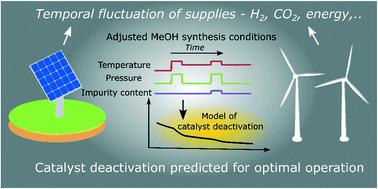当前位置:
X-MOL 学术
›
React. Chem. Eng.
›
论文详情
Our official English website, www.x-mol.net, welcomes your
feedback! (Note: you will need to create a separate account there.)
Sulphur poisoning, water vapour and nitrogen dilution effects on copper-based catalyst dynamics, stability and deactivation during CO2 reduction reactions to methanol
Reaction Chemistry & Engineering ( IF 3.4 ) Pub Date : 2022-01-05 , DOI: 10.1039/d1re00486g Anže Prašnikar 1 , Blaž Likozar 1
Reaction Chemistry & Engineering ( IF 3.4 ) Pub Date : 2022-01-05 , DOI: 10.1039/d1re00486g Anže Prašnikar 1 , Blaž Likozar 1
Affiliation

|
To reduce CO2 emissions, a flexible process operation for chemical methanol synthesis may be required as the supply of renewable energy-based feedstocks fluctuates. Analysis for the determination of the changing conditions of the long-term activity of catalysts is therefore important for efficient industrial production. A commercial Cu/ZnO/Al2O3 catalyst and five other materials (CuBaTiOX, CuCaTiOX, CuCeAlOX, CuSrAlOX and CuSrTiOX), prepared using solution combustion methods, were tested at two different pressures (p), followed by ageing at high temperature (T) jumps to show the effects of sensitivity. Surfaces were characterized by N2 physisorption, scanning electron microscopy, coupled with energy dispersive spectroscopy (SEM-EDS), and crystallographic X-ray diffraction (XRD) with additional structural Rietveld refinement. Stability reduction mechanisms were assessed, a model was developed with the applied relative partial p of reaction product species as input, and, for CuCeAlOX, it was demonstrated that the kinetics of deactivation is related to a unified H2O gage p distribution, while excluding the correlations of other four prevalent gases (hydrogen, carbon dioxide, carbon monoxide and methanol). An activity decrease can be predicted. Interestingly, synthesized SrCO3-containing mixtures exhibited a lesser loss of initial methanol synthesis activity at 50 bar than at 20 bar during time-on-stream increased T application. In addition, the activity relationship of the catalysts with N2 and H2S poisoning was described. A linear performance differentiation as a function of the amount of H2S impurity was observed, presented and mechanistically modelled. Carbon capture and utilisation technologies, power-to-liquid and e-fuels, will often require (realistic) non-steady state dynamics, which we herein simulate catalytically.
中文翻译:

硫中毒、水蒸气和氮气稀释对铜基催化剂动力学、稳定性和在 CO2 还原为甲醇的反应过程中失活的影响
为了减少 CO 2排放,随着可再生能源原料供应的波动,可能需要灵活的化学甲醇合成工艺操作。因此,确定催化剂长期活性变化条件的分析对于高效的工业生产具有重要意义。使用溶液燃烧法制备的商用 Cu/ZnO/Al 2 O 3催化剂和其他五种材料(CuBaTiO X、CuCaTiO X、CuCeAlO X、CuSrAlO X和 CuSrTiO X )在两种不同的压力 ( p ) 下进行了测试,然后是高温老化(T) 跳转以显示灵敏度的影响。表面通过 N 2物理吸附、扫描电子显微镜、能量色散光谱 (SEM-EDS) 和晶体 X 射线衍射 (XRD) 以及额外的结构 Rietveld 细化来表征。评估了稳定性降低机制,以应用的反应产物种类的相对部分p作为输入开发了一个模型,并且对于 CuCeAlO X,证明失活动力学与统一的 H 2 O 计p分布,同时排除其他四种流行气体(氢气、二氧化碳、一氧化碳和甲醇)的相关性。可以预测活动减少。有趣的是,合成的含 SrCO 3的混合物在 50 bar 下的初始甲醇合成活性损失比在 20 bar 下在运行时间增加T应用期间的损失更小。此外,描述了催化剂与N 2和H 2 S中毒的活性关系。作为 H 2量的函数的线性性能差异观察、呈现和机械建模了 S 杂质。碳捕获和利用技术、电力到液体和电子燃料,通常需要(现实的)非稳态动力学,我们在此进行催化模拟。
更新日期:2022-01-05
中文翻译:

硫中毒、水蒸气和氮气稀释对铜基催化剂动力学、稳定性和在 CO2 还原为甲醇的反应过程中失活的影响
为了减少 CO 2排放,随着可再生能源原料供应的波动,可能需要灵活的化学甲醇合成工艺操作。因此,确定催化剂长期活性变化条件的分析对于高效的工业生产具有重要意义。使用溶液燃烧法制备的商用 Cu/ZnO/Al 2 O 3催化剂和其他五种材料(CuBaTiO X、CuCaTiO X、CuCeAlO X、CuSrAlO X和 CuSrTiO X )在两种不同的压力 ( p ) 下进行了测试,然后是高温老化(T) 跳转以显示灵敏度的影响。表面通过 N 2物理吸附、扫描电子显微镜、能量色散光谱 (SEM-EDS) 和晶体 X 射线衍射 (XRD) 以及额外的结构 Rietveld 细化来表征。评估了稳定性降低机制,以应用的反应产物种类的相对部分p作为输入开发了一个模型,并且对于 CuCeAlO X,证明失活动力学与统一的 H 2 O 计p分布,同时排除其他四种流行气体(氢气、二氧化碳、一氧化碳和甲醇)的相关性。可以预测活动减少。有趣的是,合成的含 SrCO 3的混合物在 50 bar 下的初始甲醇合成活性损失比在 20 bar 下在运行时间增加T应用期间的损失更小。此外,描述了催化剂与N 2和H 2 S中毒的活性关系。作为 H 2量的函数的线性性能差异观察、呈现和机械建模了 S 杂质。碳捕获和利用技术、电力到液体和电子燃料,通常需要(现实的)非稳态动力学,我们在此进行催化模拟。











































 京公网安备 11010802027423号
京公网安备 11010802027423号